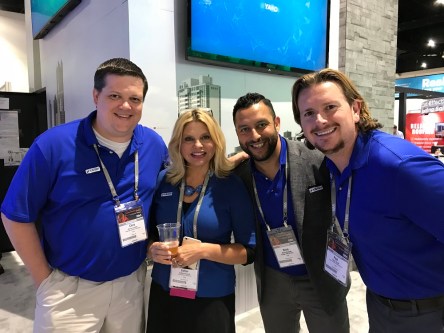The multifamily industry converged in San Diego last week for Apartmentalize Powered by National Apartment Association. Formerly known as the NAA Education Conference and Exposition, the annual event is the largest educational conference for apartment industry professionals. We highlight five of our favorite lessons from this year’s event. 5 Lessons from Apartmentalize 2018: Own the Age of AI On Thursday, industry experts discussed the impact of artificial intelligence in multifamily. Panelists included Dawn Wise from Berkshire Communities, Michael Barry from Bozzuto, Tim Reardon from Bridge Property Management, and Yardi’s Dhar Sawh. Artificial intelligence has just recently emerged in the rental housing industry. “This is so new for our industry, so the sky’s the limit,” explained Reardon. The session explored the benefits of artificial intelligence, big data, and business intelligence tools. How can you get energized for the Age of AI? Top tips from panelists: learn more about AI, and make a data strategy plan. Today’s Renters Have a Multi-Touch Journey Over the last two decades, we’ve gone from tracking walk-ins and phone calls to embracing comprehensive CRM systems. On a panel moderated by Yardi’s Esther Bonardi, Holli Beckman from WC Smith, Israel Carunungan from Greystar, and Mia Wentworth from CWS Apartment Homes discussed multi-touch lead attribution, a model for tracking and weighing touchpoints in the lead-to-lease cycle. How can smart marketers improve lead tracking? “Dig into it, study it, and it can open a whole new world,” advised Bonardi. Learn more about multi-touch lead attribution and download our free eBook. Sustainability Wins At Friday’s Apartmentalize session, panelists including Yardi’s Martin Levkus explored resident engagement through energy efficiency. In a recent National Apartment Association survey, windows were the top sustainability item residents cared about. For one panelist, energy efficient windows resulted in a $75 per month...
Holli Beckman
On Multi-Source Lead Attribution
Property marketers use lead attribution to determine where leads are coming from so they know what is working, what isn’t and where to spend their marketing dollars most effectively. But single source lead attribution models only credit the first or last source with the lease. “We know that 50% of renters visit five or more websites before they even set foot inside your leasing office. But we only give one source credit for the lease?” says Holli Beckman, vice president of marketing and leasing operations at WC Smith. “If 100% of attribution is going to the first touch, then you are indicating that none of the other sources have any value.” So how do we fix it? How do we more accurately assign value to all the touchpoints that prospects interact with on their buyer journey? The answer is multi-source lead attribution. It’s a relatively new model in multifamily, and it’s a topic Beckman is passionate about (check out her article “Why the Multifamily Industry Is Missing the Boat on Multi-Source Lead Attribution”). So is the development team at Yardi. We’re constantly evolving RentCafe CRM to accommodate new data points and provide deeper insight into prospect activities and marketing sources. That’s why we invited Beckman to join us at the Yardi Marketing Forum in Beverly Hills this week to share her insights as we preview new lead attribution tools designed to increase accuracy and ROI for property marketers. Before the forum, we had a chance to catch up with Beckman and ask her a few questions related to her session and trends she is seeing right now. What limits property marketers’ ability to deliver leads? Beckman: A true understanding of customer behavior. For so long we’ve only reported on one step of the customer...
Success Stories
CRC Does More with Yardi
Little makes us happier than hearing about a client’s success with one of our products. Unless that same client is experiencing success with three of our products! We recently had exactly that happen when we sat down to chat with Belinda Torres and Heather Palmer of Continental Realty Corporation (CRC) about their experience with RentCafe. It turned out that CRC wasn’t just getting positive results and feedback from using RentCafe, the company was also seeing measurable returns by extending its marketing platform with both RentCafe CRM and RentCafe Reach. Keep reading to see how CRC improved their online presence, lead tracking and organic traffic with a suite of integrated marketing solutions. Meet CRC CRC was founded in 1960. Headquartered in Baltimore, it’s a full-service multifamily and commercial real estate investment and management company. It uses Yardi software to manage a diversified portfolio featuring nearly 10,000 apartment homes and retail centers consisting of more than 3.5 million square feet of space. Better Websites Before adopting RentCafe, CRC had a corporate website that hadn’t been redesigned in a decade and didn’t have individual property websites. “There wasn’t any SEO value,” said Torres, corporate marketing director at CRC. “Keywords and alt tags weren’t being utilized. There was nothing to help a prospective resident find us.” CRC used RentCafe to create marketing websites for every multifamily property in its portfolio. CRC also uses COMMERCIALCafé to create websites for its commercial properties. “The websites that we have now are attractive. Photos and tours are what people want to see, and we’ve been able to give that to them with RentCafe,” said Torres. The sites are mobile-friendly and allow the marketing team to upload videos and custom content for each community. Applicants can apply online and receive and submit all...
Lead Tracking and SEO
What you need to know
What you don’t know can hurt you. It’s true of the foods we eat and the medicines we take. It’s also true of the decisions we make regarding lead tracking and digital marketing presence. This may come as a surprise. While lead tracking numbers help you determine marketing return on investment (ROI), they can also be your website’s worst enemy if you don’t follow some important guidelines on when, where and how to use them. The Lead Tracking Prescription For years, the multifamily industry has focused on solid lead-source tracking. Before the introduction of lead tracking systems, multifamily managers and marketers relied on lead-source information entered manually by leasing agents, based on the answers given by customers, to determine marketing ROI. But let’s face it: in spite of best intentions, the data gathered was full of holes. Enter automated lead tracking of phone numbers and emails, and the problem was nearly solved. The adoption of lead tracking services was rapid and effective. With electronically tracked lead source data in hand, marketing directors could make informed decisions on where to place money and energy to drive leads. As additional online channels entered the picture—including social media and free local business listings—we slapped a lead tracking number on them all. We have become an industry of forensic marketing examiners on a data quest. The Side Effects But there’s a wrinkle, and it’s a big one. It’s called Local Search Engine Optimization (SEO). Apartment websites depend on local search results to drive traffic. Local search results depend on SEO. And good SEO depends on domain authority driven by local citations. So what is a local citation? Moz.com—a company specializing in SEO—defines a citation as “mentions of your business name and address and phone number on other webpages.” They go on to say citations are a key component of ranking algorithms, especially in Google and Bing. With all other things equal, websites with a greater number of local citations rank higher than businesses with fewer citations. So what’s the conflict? All three items—name, address, and phone number—must match between your website and your web listings to create a strong citation. When we add tracking numbers to our websites, and add different tracking numbers to social listings and local business listings such as Yahoo Local, YellowPages.com, and Google My Business, we break our citations. Thus, our website authority begins to decay. The Healthy Balance Here are three steps to a healthy lead tracking/SEO balance. Make sure your marketing website always displays your local business phone number. You can add a tracking number to your website, but be careful not to replace your local business number completely with a tracking number. You should integrate Schema.org micro data for local business information, so that search engines recognize and index your local business name, address, and phone number. You may also display the lead-tracking number as an image, rather than as crawl-able text, so that search engines recognize only your local number. However, discuss your options with your website provider, to ensure your best strategy. Use lead tracking numbers on all of your paid advertising. If you are paying for it, you definitely want to track it. For all other web listings, consider the primary purpose of the listing and make your decisions accordingly: If the primary purpose of the listing is to drive leads, as in the case of classified advertising on Craigslist, then you will want to track the source. For social media, the primary purpose is resident engagement, social search signals and business citations that drive web traffic. Rarely does a customer visit a social site to look for an apartment. Social accounts typically should not include a lead tracking number, as the loss of authority from local business citations is greater than your inability to track a few leads that may come through that channel each month. By following this healthy regimen, you will...



